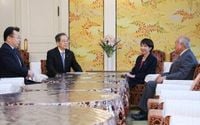Japan’s political landscape was jolted this week when Komeito, the centrist Buddhist-backed party and a fixture in the ruling coalition for over a quarter-century, announced its departure from its partnership with the Liberal Democratic Party (LDP). The decision, made public by Komeito leader Tetsuo Saito after a ninety-minute meeting with new LDP president Sanae Takaichi on October 10, 2025, signals one of the most consequential shifts in Japanese politics since the coalition’s inception in 1999, according to Jiji Press and AP.
For 26 years, Komeito and the LDP had weathered the storms of Japanese politics together, even standing side by side during the LDP’s brief stint in opposition from 2009 to 2012. But the alliance, long seen as a stabilizing force in the Diet, was increasingly tested by demographic changes, mounting public distrust after a series of high-profile scandals, and growing frustration among Komeito’s supporters over the compromises required to keep the coalition afloat. The decision to end the partnership was not made lightly, but as Saito explained to reporters, it was time to “wipe the slate clean” on cooperation with the LDP, including mutual endorsements in parliamentary elections.
The immediate fallout has been significant. The LDP, already struggling to maintain its legislative grip, now finds itself 25 seats short of a majority in the upper house and 37 seats shy in the lower house. With Komeito’s 24 seats in the House of Representatives and 21 in the House of Councillors out of reach, the LDP’s ability to govern—let alone elect Takaichi as prime minister in place of Shigeru Ishiba—has been thrown into doubt. The extraordinary session of the Diet, originally scheduled for October 15 to formalize the leadership transition, has been postponed as the LDP scrambles to secure support, reports Asia Times.
So why did this break happen now? The answer, it seems, is a tangled web of political missteps, ideological rifts, and, above all, a crisis of trust. Komeito’s electoral base has been shrinking, dropping from more than 6.5 million votes (13%) in the 2019 upper house elections to just 5.2 million votes (5.37%) this year. Part of this decline is demographic, with an aging supporter base and changes within the Soka Gakkai religious movement that underpins Komeito, especially after the death of its longtime leader Daisaku Ikeda. But the party also believes it has paid a steep price for its association with the LDP, whose reputation has been battered by scandal after scandal.
According to the AP, the final straw for Komeito was the LDP’s lackluster response to the latest round of corruption allegations—specifically, the political slush fund scandals that have ensnared dozens of lawmakers, many linked to a faction once led by the late Prime Minister Shinzo Abe. Saito was blunt in his assessment, saying, “The LDP’s response was that it will think about it, which was highly insufficient and extremely disappointing.” While Saito said he found Takaichi’s responses to concerns over Japan’s wartime history, her visits to the controversial Yasukuni Shrine, and her hardline stance on foreigners to be acceptable, he was unmoved by her approach to cleaning up corruption.
There were other flashpoints as well. Takaichi’s early moves as party leader—such as a secret meeting with opposition Democratic Party for the People (DPFP) leader Yuichiro Tamaki before any terms had been hashed out with Komeito, and her decision to include scandal-tainted Koichi Hagiuda in her leadership team—were interpreted by Komeito as “slaps in the face,” according to Asia Times. Further complicating matters was Takaichi’s reliance on LDP heavyweight Taro Aso, who had previously referred to Komeito as a “cancer” in the coalition, reinforcing the perception that the LDP’s right wing saw Komeito as an impediment to its ambitions.
With the coalition’s collapse, the parliamentary arithmetic has shifted dramatically. The LDP, with only 196 seats, faces a formidable opposition bloc. The Constitutional Democratic Party (CDP), DPFP, and Ishin no Kai together command 210 seats; if Komeito were to join forces with them, the opposition would boast 234 seats—an absolute majority. While Komeito has ruled out supporting an LDP-led government from outside the cabinet, its intentions regarding an alternative coalition remain unclear. As Saito told Jiji Press, Komeito will not become an automatic opposition party, but will work with the LDP on issues of mutual interest.
For Takaichi, the timing could hardly be worse. The LDP’s leadership contest had been framed as an opportunity to expand the coalition and chart a new course, but with Komeito gone, the party is left scrambling for partners. Neither the DPFP nor Ishin no Kai has shown much enthusiasm for joining a weakened LDP, wary of the reputational cost and the prospect of being tethered to a government in crisis. Meanwhile, the DPFP’s principal backer, the labor federation RENGO, has made clear its opposition to supporting an LDP-led administration.
The opposition, for its part, sees a rare opening. CDP leader Noda Yoshihiko described the moment as a “once-in-a-decade” chance to drive the LDP from power. Yet, past attempts at multi-party coalitions—most notably in the early 1990s—have foundered on ideological differences and the sheer complexity of governing with a patchwork of parties. Still, as Asia Times notes, the current fluidity in Japanese politics means that previously unthinkable alliances may be on the table, at least for a short-term government focused on political reform and a supplemental budget before calling a snap election.
What does all this mean for the average Japanese voter? Instability, for one. With no party able to muster a clear majority, the path forward on critical issues like fiscal consolidation, defense spending, social security, and agricultural reform looks murky at best. The risk is that weak governments will be unable to tackle the country’s most pressing challenges, leaving Japan’s voice diminished on the international stage and providing an opening for anti-establishment parties like Sanseitō.
Komeito, meanwhile, faces its own identity crisis. Without the coalition, the party may struggle to win single-member districts and could see its influence wane, resembling the Japanese Communist Party’s diminished but persistent presence. Yet, it remains a force in local politics and could find itself back in government if Japan’s era of fluid, multi-party coalitions continues. For now, though, the era of LDP-Komeito dominance is over, and the country’s political future is more uncertain than it has been in decades.
Japan stands at a crossroads, with its once-stable political order upended and every major party recalibrating for a new, unpredictable era.




